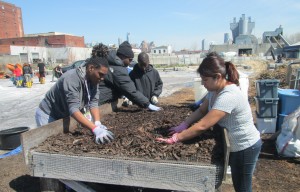Wild in the City

To view the photo-rich magazine version, click here.
Originally appears in the Fall 2016 issue
by Emily Stoeth
SO YOU’RE THINKING of taking your inner-city class on a field trip to study ecology or natural spaces? I’ll bet you’re planning to travel outside of the city—perhaps to a large forest or preserve? Have you considered staying local instead? There has long been a trend in urban
environmental education (EE) to take students from urban areas into suburban or rural areas to experience “real nature.” But all this practice does is send the message that urban areas do not have enough nature to warrant study.1 We do not need to take city kids far away in order to teach them about nature and ecology.
As urbanization increases, it is all the more important that we as educators turn our focus to exploring the future of ecology—the unique biodiversity that thrives in metropolitan areas. Students in urban areas should learn about nature that is relevant to them in their everyday lives rather than what exists only in far-away places. Not only is urban EE less expensive, but more importantly, it can increase a student’s
connection to their environment and ultimately their sense of environmental stewardship. Let’s stop taking kids out of the city for nature field trips and shift our outdoor exploration focus towards city ecosystems. In this article, I hope to provide you with the essential tools to facilitate this type of unique learning with your students.
This content is restricted to subscribers only.
If you are not yet a subscriber, please consider taking out a subscription here.
If you are an existing subscriber, kindly log in or contact us at info@greenteacher.com for more information.





